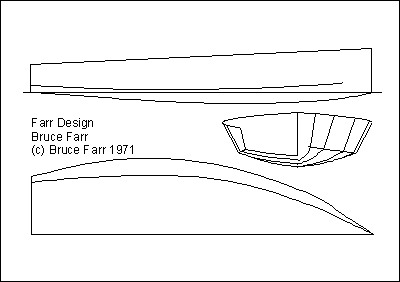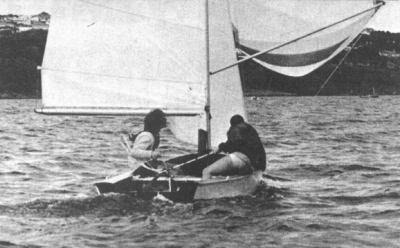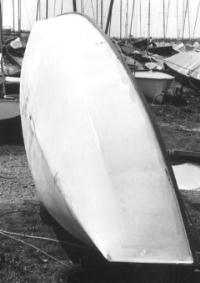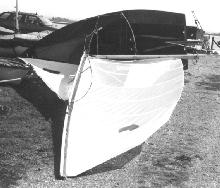

Queenie S.J.B., as the name is normally abbreviated to, was built in New Zealand, probably towards the end of 1971. It is supposed to have been built by John Paterson for his son to race. The boat was launched about a month before the 1972 World Championships, and placed 5th in the worlds, and 3rd in the NZ Nationals just before. A Bruce Farr design, she was designed to the Cherub Class hull restrictions. There were a number of Queenie SJBs (including at least one NZ Javelin as well as the Cherubs. Two of which have ended up in the U.K., and this is Queenie SJB 2. At this time it was common for Cherubs to race as Q Class, using the Cherub rig as the number 3 (heavy weather) rig, and bigger masts and sails in lighter conditions. When I got the boat I was told that it had won the Q nationals twice, but recent information from New Zealand suggests that those successes were to the first QSJB, and this boat only sailed as a Cherub.

In 1974 she was certainly rigged as a Cherub, and the Mark Paterson and Brett Baker used her in the New Zealand trials, and subsequently in the 1974 Cherub Worlds, which were held in Torbay, England. In the worlds they finished 3rd, behind Mandy Wilmot and Nicola Bethwaite of Australia. At this time I believe she was rigged with a spigoted pole mast with spreaders, with the spigot supported by a sort of secondary foredeck, the actual foredeck stopping off level with the front bulkhead. There is no mention of this in a 1972 Worlds review article I have however. The internal layout was slightly unconventional when launched, although it later became widespread. The Farr design included full length side tanks and conventional decks, and this was the first boat to have short side tanks. The radiused traveller was unsual, but not unique. The daggerboard case is about 3" further aft than most UK built Cherubs.

Queenie SJB at the 1974 Worlds. Photographer unknown (sorry!)
After the worlds she was sold to the Hill family in the U.K., and sailed by them for a few years, always near the top of the fleet, but never actually managing to win a Nationals. From there she went to Nick Mason, who removed the mast sub-frame, and rerigged her with a 1 1/2" keel stepped Needlespar, with 2 sets of spreaders and lowers. Although not as fast as some newer boats downhill, the boat could still keep up with most upwind.
The last change of ownership came in 1986, when I bought the boat from Nick. I rerigged her yet again, with an over rotating mast - an oval section untapered Needlespar, and a suit of sails to the 1984 rules. I also redecked her to the present layout with a swept back foredeck. Unfortunately by this time the boat was getting fragile with advancing age, but in between breakages the boat was still demonstrating good upwind speed, and in 1987 was 4th at the Queen Mary open meeting, and 9th overall at the Nationals, having been 1st, 3rd and 4th to the windward mark in the last 3 races. In 1998 I experimented with supporting the wing mast on a stump at gooseneck height. which was not a success - the stump was only supported with lowers and these kept breaking, sending the end of the mast through the foredeck.
It was, I think, in 1988 that the boat suffered a nearly
catastrophic failure at the Weston Grand Slam. I was sailing with Tim
Dean, who's now of course well known in the Cherub Class, and it was a
particularly lumpy Force 5. As I remember we were powering straight into
the waves on a closish reach at a fairly dramatic velocity when we
caught a particularly big one, went right up in the air, and down on the
next wave coming up... There was a horrendous crash, and I looked up in
sure and certain expectation of seeing the mast coming down on top of
me. However all still appeared to be where it should be, and we carried
on, until a few waves later Tim said
"Jim, your floor's going up and down."
"No way", I said, "Its got two good sized
stringers down the floor, it can't be moving!"
"Jim, your floor's going up and down."

At that point we decided discretion was the better part of valour, and nursed the old lady gently back to the beach. On inspection both stringers had snapped on the port side and come unglued from the floor, the ply had cracked right through each side of the mast step, there was another crack by the port chine in the cockpit, and the centreline seam had partially split from two feet from the bow back to the centreboard case. For once I decided that I had better invoke the insurance company for this one, and Moth builder/sailor John Pearce made a thorough job of the repairs.
However by this time I'd decided that it was time to change boats, and a career change provided the money, so in 1989 I built a new boat, and Queenie was retired. The last outing was at a Queen Mary Open meeting which must have been very unremarkable as my memory has almost entirely failed me. I can remember sailing Queenie with my brother, and I know I took out the Bethwaite wing mast, which I'd recently restored. There is an extant photograph which appears to show her near the front of the fleet in glassy conditions, plus a couple of shots of her in the dinghy park which are reproduced here.
She is now rigged in a representative 1974 form, with the original radiused full width traveller used for the 1974 worlds. The mast is a Bethwaite designed Pine/Balsa wing mast from the Nicola Bethwaite's boat Slithy Tove, the 1974 world championship runners up. Its not known whether this was the rig Bethwaite used in the Worlds or a spare. I also have the original Australian Elvstrom mainsail, although I normally use a more recent Caws mylar main. The rig was also bought by the Hills after the 1974 worlds, and used by Mark and Bruce Hill on their boats Tangerine Dream and Cachaça. To quote from Bethwaite Design "By the early to mid seventies, Nicola was competing in the Cherub class and Julian had started his "apprenticeship" in 18ft skiffs. Frank had been experimenting with a flatter than average underwater shape as well as developing a practical over-rotating mast for use without spreaders. All of these elements came together from 1974 to 1976 when Nicola and Julian sailed together to win two Australian Cherub Championships and then a year later, the World Cherub Championship, in a hull evolved by Frank from Mark's "Medium Dribbly" NS14, with an over-rotating mast and sails developed by Mike Fletcher and Ian MacDiarmid of Elvstrom Sails." I've recently bought a new jib and spinnaker to early 1980s designs but have older ones which are New Zealand North, and were used by the 1980 World Championship winner, Flat Stanley.
Jim Champ
This picture shows Queenie in the Dinghy park at Queen Mary, with the
Bethwaite wooden mast but a Mylar Caws 1984 rules mainsail.